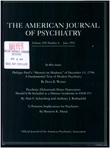Is locked seclusion necessary for children under the age of 14?
Abstract
A retrospective study of the effect of the implementation of an unlocked seclusion policy was conducted on three child psychiatric inpatient units in a state hospital in Pennsylvania. Unlocked seclusion was associated with 1) increased use of tranquilizing medications administered as needed on all three units, 2) increased clustering of medications, administered as needed, in the units that used seclusion most, 3) diverse changes in the three units regarding frequency and clustering of unlocked seclusion, and 4) increased correlations between medications administered as needed and seclusion, particularly in the more behaviorally disturbed children. These findings suggest that locked seclusion may be a necessary therapeutic intervention, particularly with severely disturbed children with serious conduct and impulsive disorders.
Access content
To read the fulltext, please use one of the options below to sign in or purchase access.- Personal login
- Institutional Login
- Sign in via OpenAthens
- Register for access
-
Please login/register if you wish to pair your device and check access availability.
Not a subscriber?
PsychiatryOnline subscription options offer access to the DSM-5 library, books, journals, CME, and patient resources. This all-in-one virtual library provides psychiatrists and mental health professionals with key resources for diagnosis, treatment, research, and professional development.
Need more help? PsychiatryOnline Customer Service may be reached by emailing [email protected] or by calling 800-368-5777 (in the U.S.) or 703-907-7322 (outside the U.S.).



